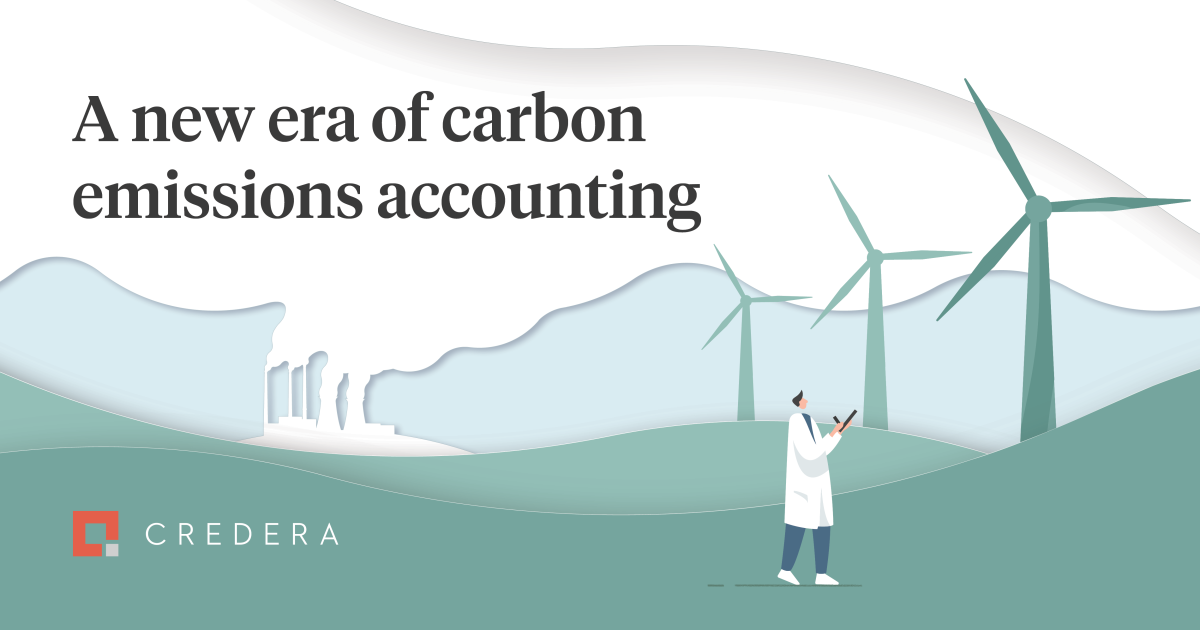
More companies are accounting for carbon emissions, and they need better data, better follow through, and a real strategy. According to data from Zero Tracker, more than half of the world’s largest publicly traded companies have set some sort of carbon emissions goal. Public pressure, investor demands for transparency, and evolving environmental regulations are driving the change, as well as the looming Securities and Exchange Commission rule in the United States and the incoming Corporate Sustainability Reporting Directive (CSRD) program in the European Union. We have entered a new era of carbon emissions accounting where reports are increasingly formalized and progress more intensely scrutinized.
Many companies will soon reconsider how they collect carbon emissions data and structure the supporting processes to track progress. It’s no longer sufficient to rely on “good enough” data or to calculate carbon emissions once per year before the environmental, social, and governance (ESG) or corporate social responsibility (CSR) report is published. Companies need a proactive carbon accounting strategy. We’ll explore how to develop specific strategies for carbon emissions accounting that enable timely, regular updates so leaders can actively take steps toward reducing carbon emissions.
Transition from “good enough” data to actionable data
Moving from “good enough” data to actionable data is critical for the new era of carbon accounting. Before highlighting why the lack of primary data can be problematic, it is helpful to review some concepts of the Greenhouse Gas (GHG) Protocol, the global standard for calculating emissions related to a company’s operations. The GHG Protocol is similar to “generally accepted accounting principles” in that there are principles that should be followed, but there are also a range of acceptable approaches depending on a company’s unique situation. For example, consider that the GHG Protocol allows a company that does not have sub-metered electricity and, therefore, cannot determine their actual usage data for their scope two electricity usage to use assumptions in lieu of precise data. A company’s electricity usage could be estimated using the area method by determining the building square footage and the energy use for the entire building.
The early use of estimations is a very common approach across scope one, two, and three in a company’s carbon accounting maturity because it requires minimal data collection, but it is far from ideal. Reliance on assumptions and calculation methods that do not leverage primary data will not accurately guide effective reduction efforts over time. In this example, the only controllable factor would be office downsizing, which may not align with the company’s strategy or business needs.
However, if a company is able to develop techniques that capture specific data, such as the exact electricity usage for the floor of the building being occupied (via submetering), they can more precisely calculate their actual emissions and achieve reductions over time. This might follow the implementation of energy efficiency measures such as installing heat pumps or the purchasing of renewable energy through power purchase agreements (PPAs), virtual power purchase agreements (VPPAs), or renewable energy credits (RECs). Having specific data helps drive positive behaviors that can encourage companies to meet their carbon emissions targets.
Transition from reactive management to proactive management
Until recently, companies would passively calculate emissions once per year to publish in an ESG or CSR report, which would be read by a limited group of shareholders or key decision-makers. This infrequent approach to measuring progress is not acceptable for reporting, monitoring, and auditing financial health of a business, and the same is now becoming true for carbon emissions. The rise of sustainability indexes (e.g., MSCI Index, Dow Jones Sustainability Index), ESG rating agencies (e.g., Sustainalytics, EcoVadis), and climate-focused organizations (e.g., CDP, Science Based Targets) scoring private companies on their progress toward emissions goals has prompted the need for more proactive carbon management.
But the reality is that current efforts to gather carbon emissions data can be painful. Even though data may technically be available, it is scattered throughout a company’s HR systems, supply chain systems, financial systems, and more. Prior to the rising scrutiny, there may not have been the pressure to regularly centralize, report, and act on this information frequently—the ad-hoc, manual survey forms and Excel spreadsheets worked well enough. But this approach is now outdated when consistent progress is an expectation, reporting is becoming more regulated, and leaders need information regularly to make decisions. A systematic approach to provide visibility on a quarterly, or even monthly, basis is required to truly influence change. That would give the right tools to chief sustainability officers, ESG professionals, and other decision-makers to make proactive decisions in support of carbon emissions goals. This proactive carbon management challenge, as well as the lack of primary data mentioned previously, can be remedied by building a carbon data strategy.
What is a carbon data strategy?
A carbon data strategy focuses on how to collect, normalize, centralize, utilize, and enrich the data that drives carbon emissions reporting and decisions. While the approach will change depending on the maturity of a company’s data architecture, building a carbon data strategy includes evaluating existing data and improvement opportunities, designing technology architecture to organize data, and developing organizational processes that enable carbon accounting to become part of “business as usual.” With concerted effort, this is possible for any company, at any level of data maturity. We’ll walk through each of these steps below.
1. Take inventory of existing data
The first step is to take inventory of existing primary data across relevant GHG categories and evaluate it across the six dimensions of data quality (completeness, accuracy, consistency, validity, uniqueness, and integrity) to understand if it will be reliable enough for carbon accounting goals. Since activity data is often sourced from multiple systems that may not tie together perfectly, this step may also require normalizing and linking activity data. The result should be a strong understanding of source, quality, and availability of data such as headcount, purchased goods, electricity usage, and number of sites or buildings. This effort will also reveal improvement opportunities for better primary data to yield a more precise carbon emissions picture.
2. Design technology architecture
The second step is to design technology architecture that can support robust carbon accounting. A first thought may be to purchase one of the many software as a service (SaaS) carbon accounting products on the market to achieve this. This can often satisfy the needs for smaller, less complex organizations with limited stakeholders and activity data. However, larger, more complex organizations should proceed with caution in thinking a SaaS carbon accounting product alone can meet their needs. SaaS carbon accounting products are only as good as the data that feeds them, and larger organizations are more likely to have complex activity data from many stakeholders.
Incomplete or inaccurate data may lead to inaccurately or inconsistently calculated emissions, especially when stakeholders are not well-versed in how carbon accounting data needs to be structured. To mitigate this risk, Credera advocates for a more structured technology architecture that places a data platform between activity data sources and SaaS carbon accounting products.
We have seen success by implementing what we call an “environmental data platform” (EDP) that centralizes activity data from stakeholders, organizes it into predefined schema, and performs governance checks for completeness and integrity. Once confirmed, the EDP passes activity data into a SaaS carbon accounting product of choice (e.g., Watershed, Planetly, Persefoni) to handle the specialized tasks of matching emissions factors, performing calculations, and visualizing carbon footprint reports. While the exact technology architecture depends on each organization’s unique situation, we have seen benefits of this approach that include increased centralized ownership of activity data with environmental experts, more flexibility to swap SaaS carbon accounting products if needed, and more rigorous governance and control of the of data through the EDP system.
3. Develop organizational processes
The third step, and perhaps the most important, focuses on setting up organizational processes to support long-term management. While exact processes and corresponding roles or responsibilities will vary depending on how organizations are set up, we have found that processes broadly fall into three categories: operational, change enablement, and strategic.
Operational processes are the technical activities that enable carbon accounting. This is everything from the initial extraction of activity data from source systems to final quality checks on a yearly emissions footprint. Many stakeholders across varying disciplines must coordinate to successfully conduct carbon accounting, making the importance of clearly defined activities and expectations crucial. The more routine the technical operations of carbon accounting, the more dependable the results.
Change enablement processes are also required to support the entire organization through an environmental sustainability journey. As organizations set their decarbonization goals, establish new guidelines/policies, change aspects of operations, and include environmental sustainability metrics as part of strategic objectives, the processes to communicate clearly become necessary. A yearly ESG report is not enough, so internal processes to regularly communicate progress should be constructed to increase understanding and adoption.
Strategic processes are the ones that steer the ship. The chief sustainability officer or chief financial officer will normally be the principal leaders when it comes to guiding how to reach sustainability goals or determining how to partner with other leaders in the organization. But strategic processes should also be set up with key departments such as HR or procurement so they can be empowered to align to sustainability goals as part of an organization-wide undertaking.
Successfully establishing organizational processes in each of these three areas will enable robust carbon accounting that is not only part of regular operations, but also continuously sees results.
Credera’s perspective and experience
Credera has helped numerous clients manage the data and strategies essential to driving their business results and now we are doing the same for their environmental data. As experienced technologists, we are tool-agnostic and aim to build the best solution for our clients. We take the time to understand our client’s environmental sustainability goals, the existing systems and data, and the underlying technology architecture before recommending a path forward.
Our approach was on display with our recent work with our parent company, Omnicom, in developing a systematic carbon accounting solution that has significantly reduced the time it takes to gather data, will drive enthusiasm with employees, and will enable frequent insight into progress against carbon reduction goals.
If you’re needing help building your carbon accounting data strategy to meet the challenges of this new era, reach out to start a conversation at marketing@credera.com.
Contact Us
Let's talk!
We're ready to help turn your biggest challenges into your biggest advantages.
Searching for a new career?
View job openings
